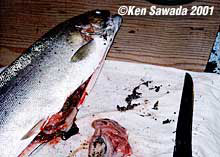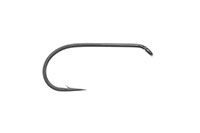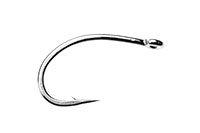
In the Lake Kamloops --Vol.33--
Shrimp
Then I wondered what bait rainbow trout eat here. Every lake in Kamloops has the crustacean called 'shrimp' by local people. It is said Kamloops trout have red flesh because they mainly eat those 'shrimp'. It was true that 'shrimp' were only food in the stomach of trout I had ever caught.However, they are not ordinary size of shrimp. Fresh water shrimp here are big zooplankton named Gammares. Their figure is very primitive. Their size is small as far as we judge from ones in the fish stomach. If they were compared to flies tied on the hook, they would be from size 14 to under size 18. Why do the fish that usually eat such tiny bait prefer a fly several times or ten times bigger? Or do they also eat much bigger bait since they frequently make rises in the evening?
I had countless questions even after I caught a lot of fish.

Board patterns of trophies were put on the lodge wall. Almost all of them were caught in 1960's.

"There used to be big fish." We heard those words everywhere as drinking talk. But this fish was really big.
I Want to Catch Big Fish
I felt only a few days had passed since I came to Kamloops but there were just 2 days left. I had caught some wild and tough rainbow trout as I changed the lake almost every day. I should have been satisfied. However, I had not achieved the most important aim of getting a big fish.I caught 3 rainbow trout in Tahoola. 2 of them were nice-sized ones of about 45cm. Their pull was strong. They were considerably big in Kamloops in those days. But I saw a lot of board patterns of trophies on the lodge wall. Some of them were over 15lb. They drew my attention. Such big fish had been really caught here! Then I watched carefully and found that most of big ones were caught in 1960's. Big patterns never belonged to 1970's and after. Ah, I've come here too late!
One evening when I came back from Tahoola, I showed my fish to the lodge owner and asked how to get bigger ones. He said it was difficult in this season but that I would have a chance in early summer. Then he added there was a single chance now.

Big fish remained in the deep spot in Little Friendly.
Friendly Lake, at 15-mimute walk from here, has the deepest spot around here. Fish can stay there safely during winter, which means it keeps big fish now. One problem is that fish come just under the water in summer but stay on the bottom now. Fishing is difficult because we have to sink the special fly deep in the water. We need special tackle. So he said.

Kamloops trout fought violently, splitting and jumping from the calm lake.
I asked what kind of flies we needed. He brought his old fly box from his room. I could not wait to see what flies he had. Then I jumped with joy. There were some big Muddler Minnows. I had the same ones and had caught some fish with them.
Actually I had planned to remain here after fishing in Kamloops, as I had done at my first tour in Canada. Later I wanted to go salmon fishing in the sea. Therefore, I had extra tackle for it.

My trophy bit size 4 Muddler Minnow. This size of Kamloops trout is big enough to show their typical style.
Little Friendly
I told him I had size 12 type 4 line, salmon rods and big Muddler Minnows now. He was very pleased as if he went fishing and explained about the point on the map.
The lodge owner showed the inside of the fish stomach. All of little black lumps were shrimp. There was no other bait.
Friendly Lake looked like a snowman on the map. Its head, the smaller part was called Little Friendly. He said there was a deep conical spot at the innermost part. I asked about a landmark and he said there were the remains of an old beaver house. Everything looked all right. I was too excited to fall asleep soon.
The next morning we three went to Friendly Lake and took a boat. We found the lake bigger than we had expected. Rowing the boat for a while, we finally found the entrance of Little Friendly. Our destination was still far. I went ahead alone. After passing the narrow part of the snowman, I saw Little Friendly in front. It did not look little at all but rather big. Following his advice, I went ahead to the inner inlet. As I came near to the inlet the water colour became dark. It looked very deep here. Then I found what seemed to be the remains of a beaver house and went in front of it. It was still deep near the shore. When I came to 20m from the beaver house I could finally see through the bottom of the lake. I can drop anchor here!
I stopped rowing and prepared for dropping anchor. Probably something moved on the bottom. I was surprised and stared at it. Several big fish I had never seen in Kamloops were swimming on the bottom. I could see them only dimly but I knew they were rainbow trout.
You can easily imagine how I got into a panic. I wanted to drop anchor and prepare for fishing as soon as possible. At the same time I was worried that my work made the fish run away. I dropped anchor as quietly as possible and hurried to put the leader to the rod. I should have put the fly to the leader in advance. I put size 4 Muddler Minnow to the leader and immediately swung the salmon rod to cast type 4 line 20m away. I wondered how deep it was. Judging from the anchor rope it was about 5m deep in front of the boat.

Why do rainbow trout jump at Muddler Minnow that is much bigger than their staple food of tiny shrimp? My questions were countless.
I waited for 20 seconds. (10 seconds might have been the right time.) Then I retrieved the line. I wanted to retrieve quickly but did it slowly to make the fly sink as deep as possible. When the running line reached the rod tip and type 4 line started coming up vertically I felt a strong bite with a thud I had never felt before. As soon as I raised the rod the reel reversed violently and a fish jumped, splitting the surface 30m ahead.
It was a powerful fish. It jumped 3 times and drew out 50m of the line. It struggled violently to the end, which was unusual for rainbow trout. Half an hour later I caught another rainbow trout of similar size. Expecting good luck again, I came back here the next day. I could catch 2 rainbow trout of over 50cm again. Now I was completely satisfied with my fishing in Kamloops.
Muddler Minnow
Why do those big rainbow trout choose nothing but Muddler Minnow? Their stomachs were filled with shrimp. There was no other bait there. When the fish eat only one kind of bait anglers usually use the imitation fly. Actually I heard the imitation fly was very effective to small trout. But when anglers aimed at big trout even the lodge owner said big Muddler Minnow was absolutely effective. He insisted his words were based on actual results. It is well-known everywhere that big fish eat different bait from small ones of the same kind. But there was no other bait here. If there were more attractive bait than shrimp, would the fish choose it? Probably the fish saw Muddler Minnow for the first time. Did it look so attractive to them?What is the real meaning of the fly? Fishing here gave me a great hope and at the same time a lot of questions. I did not answer properly but at least I became free from the popular view that anglers should use the imitation fly of the real bait there.
-- To be continued --
- NET SHOP INFORMATION

SL6 Black Spey Hooks

DU3 Limerick Spinner Hooks

SL4 Single Bartleet Hooks

XD1 Tube Fly Double Hooks

DD2 Flat Perfect Hooks

DD1 Black Terrestrial Hooks

TD4 Old Limerick Wet Hooks

DU1 Silver May Hooks

MU1 Flat Midge Hooks

LD3 Long Limerick Hooks

TD2 Summer Sproat Hooks

XS1 Tube Single Silver Hooks

TD6 Siver Sedge Hooks

SL5 Black Spey Hooks

DU3 Limerick Spinner Hooks
- TROPHY CLUB
- FLY SHOW
- EXHIBITION
- MASTERS`
- FLY DRESSING CONTEST Archives
- TRAVELLER Archives
- TACKLE IMPRESSIONS Archives
- ANGLERS` PHOTO GALLERY Archives
- ----------------------------------------------
- トロフィークラブ
- フライショー
- エキシビション
- マスターズ
- フライドレッシング・コンテスト・アーカイヴ
- トラヴェラー・アーカイヴ
- タックル・インプレッション・アーカイヴ
- アングラーズ・フォトギャラリー・アーカイヴ
株式会社サワダ 185-0021 東京都国分寺市南町3-13-4
SAWADA'S INC. 3-13-4 Minamicho, Kokubunji, Tokyo 185-0021, Japan
写真・ドキュメントの無断転載を禁じます。
All the images and documents found on this site are owned by Ken Sawada and may not be used without permission.
But, link to this site is FREE.
Copyright © 2000 - 2024 SAWADA'S INC.. All rights reserved.
SAWADA'S INC. 3-13-4 Minamicho, Kokubunji, Tokyo 185-0021, Japan
写真・ドキュメントの無断転載を禁じます。
All the images and documents found on this site are owned by Ken Sawada and may not be used without permission.
But, link to this site is FREE.
Copyright © 2000 - 2024 SAWADA'S INC.. All rights reserved.
